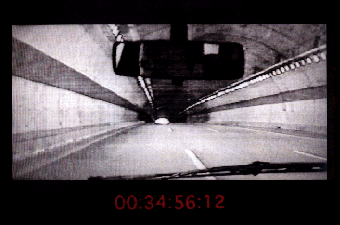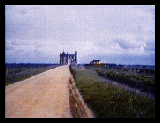Augusto Alves da Silva
contact: Tel/Fax +44 (0) 181 348 6607


So far, so good (Lisbon 96), 1996
Two videos presented simultaneously on a screen and a monitor (71 minutes)
Augusto Alves da Silva, in 'Lisbon 96', exhibits a work that evaluates certain aspects of contemporary urban planning through the recording of the boundaries of the city of Lisbon. The nucleus of this project, with 2 interconnected videos presented simultaneously, consists of getting to know a city through journeys along the boundaries that exemplify ecological and socially controversial situations, based above all on the use of the car, and with the simple objective of 'dislocation' as an urban parameter of the city's growth.
One of the videos, in black and white, shows a journey in the surroundings of the city, starting and ending in the same place, outside the city, which is seen via the routes of access, and is never actually entered. The recording is made from a fixed camera in a car driven by the artist, whose face is reflected in a mirror, thus underlining his non-identity as driver. The images follow one after the other, giving the spectator a view of the road, as if s/he was the driver. Projected on a screen painted on a black wall, they are timed by the insertion of a digital chronometer in the video. However, the time measure is of the duration of the video rather than the real time of the journey. There is no montage effect in this temporal ambiguity. The image was only speeded up in relation to the original, condensing real time into a shorter period than the one recorded. Real time is in this way equally transformed into the time of its' reception, that is the time it takes the viewer to look at the images. It therefore places the viewer in the position of the driver, by means of a process of substitution which is similarly changed into a relationship of identity and non-differentiation. Both share the same time, an illusion that is added to a situation which is already illusory.
The effect of reality thereby produced is further reinforced by a sound installation, consisting of the recording of the sound of the car engine through a microphone inside the engine. The realism of this image results from the hyper-real perception of the sound. The noise of a car engine is normally perceived from the outside, which is not the case here. There is an analogy with our perception of the human voice: the way we hear ourselves is not the way others hear us, due to the different positioning of the sound reception between transmitter and receiver in a communicative situation, so that we are all surprised when we hear a recording of our voice for the first time. What happens here is the opposite. We hear the sound of an engine amplified from 'inside' the engine, which makes the sound rhetorically more real than the reality we would expect. The speeding-up of the image and its' conjuction with this effect of sound intesity suggests the intertexts of the films of Formula 1 races and computer games, which is in the same way already implied by the configuration of the film shot. These intertexts are perceived as images socialised by popular media culture, which is how any motorist is projected in the social perception of others.
A second video starts to be exhibited on a television monitor a few minutes after the first. In this video the artist shows silent images of various suburbs of the city, and the different systems of public transport that operate there; this is alternated with periods where there is no image, in which we hear the recording of the sounds of seagulls becoming more and more strident. Many of these images use the strategy of photographic framing to suggest a fixed context in which any event, however dimly lit may be shown, is nevertheless transformed in a way that surprises the viewer. The photographic perspective is reinforced by the movement that deconstructs it without denying it. All these sets of images are structred as micro-narrratives, where the effect of surprise can sometimes give rise to humour or the absurd, very old strategies for the problematisation of the real. This happens, for example when a car breaks down in a traffic jam, when itsí driver animates an image that until then had seemed to be just a photograph of a traffic jam; and again when a group of seagulls in a puddle is interrupted by the unexpected choreography of a pigeon that appears among them. At other times these micro-narratives are shown as stages of a continuous journey, short periods of longer itineraries, as when we see the water passing by on a river trip, or when we see the landscape from a suburban train on a journey betwwen two stations. This entire second video establishes a set of urban micro-places that constitute other such allegories of the hidden side of the contemporary city, which is in its' turn enveloped in the itinerary and interwoven around it by the projection on the wall of the first video of the motorist's journey. Political and social issues arising from the disordered growth of the city are thus expressed in the dialogue between the two videos. The city is Lisbon in 1996, a city that is seen from a different place from what is suggested by publicity and promotion campaigns, a city lived in from places that, from being so often seen become invisible, August Alves da Silva returns to us this lost vision, which is also the perspective of our indignation when we confront the boundaries of any city from the moment we see them. The fact that the city we see is Lisbon is of little importance, since all cities that have been planned around the motor-car and speculation will be recognised in this 'Lisbon 96'.
João Fernandes
curator of 'More Time; Less History', Fundação de Serralves, Porto



